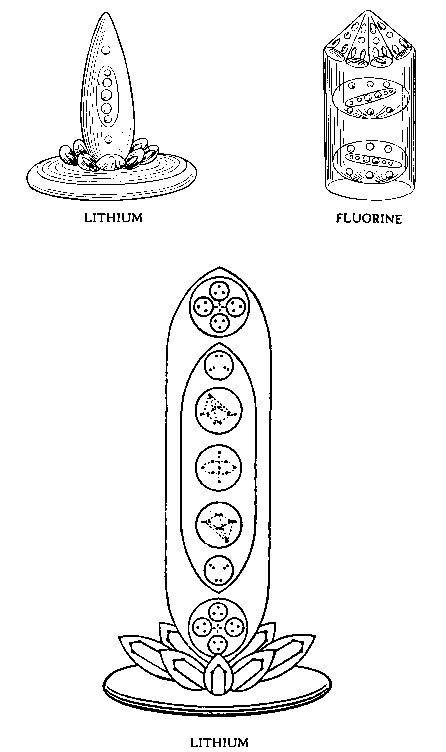
FIG. 21. ELEMENTS SPIKE GROUP
THE SPIKE GROUP
ALL the eleven elements in this group occur on the left-hand swing of the pendulum. They are all of the spike type, somewhat similar to the diagram in Fig. 21, which is that of Lithium. In most cases, however, there are a number of spikes of equal size, instead of one large spike and a number of smaller petals as in Lithium. Fluorine does not conform to the type since its spikes are reversed.
From Potassium onwards the constituent group N 110 appears as the centre from which the spikes radiate. The most striking component in all the elements of this groups is that termed the Lithium spike. Li 63.
How, with this Li 63 and N 110 as units, the elements of this family are generated can be studied from the diagrams. Of course, additional smaller bodies are brought in but a wonderful symmetry appears, as if a Grand Geometrician were indeed the Builder.
THE SPIKE GROUP
|
|
|
|
|
|
|
|
127 | Lithium | 4 Li 4 | 1 (Li 63) + 8 Ad 6 |
|
|
340 | Fluorine | 2 N 110 | 8 (2 Be 4 + H 3' + Li 4) |
|
|
701 | Potassium | N 110 + 6 Li 4 | 9 (Li 63) |
|
|
992 | Manganese | N 110 | 14 (Li 63) |
|
|
1,530 | Rubidium | 3 N 110 | 16 (Li 63 + Rb 12) |
|
|
1,802 | Masurium | 3 N 110 | 16 (Li 63 + Ma 29 (a or b) |
|
|
2,376 | Caesium | 4 N 110 | 16 (Li 63 + 2 Ma 29 a) |
|
|
2,640 | Illinium | 4 N 110 | 16 (2 Li 63 + 119 or Il 14) |
| 2,736 | Il. Isotope | 4 N 110 | 16 (2 Li 63 + 1117 or Il 18) | |
|
|
3,096 | Thulium | 4 N 110 | 16 (2 Li 63 + Tm 40) |
|
|
3,368 | Rhenium | 4 N 110 | 16 (2 Li 63 + Re 57) |
|
|
4,006 | 87 | 5 N 110 | 16 (3 Li 63 + 87.27) |

FIG. 21. ELEMENTS SPIKE GROUP
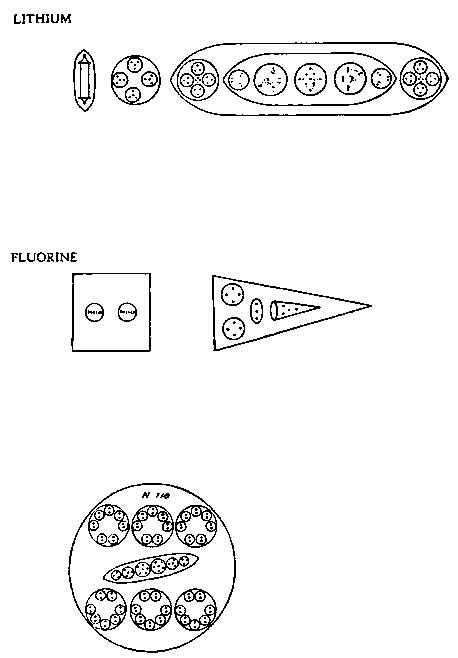
FIG. 22. LITHIUM, FLUORINE
THE SPIKE GROUP 49
ATOMIC NO. 3.
LITHIUM
Lithium is a striking and beautiful form, with its upright cone, or spike, its eight radiating petals at the base of the spike; and the plate-like support, in the centre of which is a globe on which the spike rests. The spike revolves swiftly on its axis, carrying the petals with it: the plate revolves equally swiftly in the opposite direction.
The central globe contains four small spheres, each of 4 Anu. These spheres are identified as Li4.
The spike contains two globes and a long ovoid; the spheres within the globe revolve as a cross. Within the ovoid are five spheres. In four of these the Anu are arranged as a tetrahedron. The central sphere has an axis of three Anu surrounded by a spinning wheel of six. This spike occurs in all the members of this family and since it contains 63 Anu in all, has been distinguished in our diagrams and for purposes of reference, as Li63.
Lithium = 4Li4 + 1Li63 + 8Ad6
| Central globe |
|
|
|
| Spike of 63 Anu |
|
|
|
| 8 petals of 6 Anu |
|
|
|
|
|
|||
|
|
|
|
|
|
|
|||
|
|
|
|
|
|
|
ATOMIC NO. 9. FLUORINE
Fluorine is a most peculiar object like a projectile. The 8 spikes, reversed funnels coming to a point, are partly responsible for this warlike appearance.
Each spike contains four small groups, three tetrads and a triplet
The cylindrical body is occupied by two spheres each containing 110 Anu. As this group occurs first in Nitrogen it is identified as N110. Fig. 22.
Fluorine = 2N110 + 8 (2Be4 + H3' + Li4)
| 2 N 110 spheres |
|
|
|
|
| 8 spikes of 15 A |
|
|
|
|
|
|
||||
| Total |
|
|
|
|
|
|
||||
|
|
||||
| Number weight |
|
|
|
|
|
|
50 OCCULT CHEMISTRY
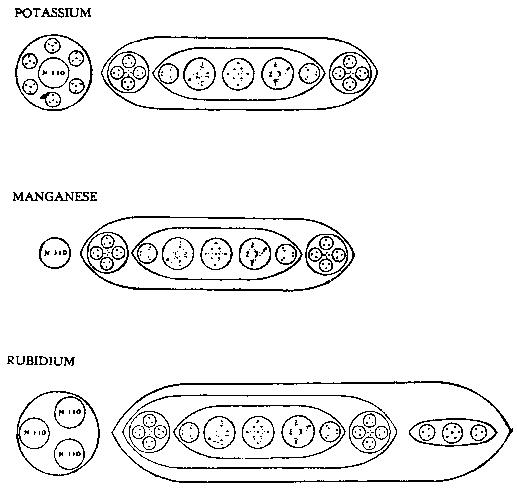
FIG. 23. POTASSIUM, MANGANESE, RUBIDIUM
THE SPIKE GROUP 51
ATOMIC NO. 19 POTASSIUM
Potassium resembles Lithium in its arrangement except that it has 9 Li63 spikes instead of 1 spike and 8 petals. Its central globe is larger and consists of a central sphere, N110, encircled by 6 small spheres of 4 Anu.
Potassium = (N110 + 6Li4) + 9Li63
| Central globe |
|
|
|
| 9 Spikes of 63 Anu |
|
|
|
|
|
|||
|
|
|
|
|
|
|
|||
|
|
|
|
|
|
|
ATOMIC NO. 25 MANGANESE
Manganese resembles Potassium but it consists of 14Li63 spikes radiating from a central globe N110.
Manganese = N110 + 14Li63
| Central globe |
|
|
|
| 14 Spikes of 63 Anu |
|
|
|
|
|
|||
|
|
|
|
|
|
|
|||
|
|
|
|
|
|
|
ATOMIC NO. 37 RUBIDIUM
Rubidium is built on the same pattern as Manganese but contains 16 spikes.
Each spike consists of the Li63 group and a smaller ovoid containing two triplets and a sextet.
The central globe of Rubidium is composed of three N110 spheres.
Rubidium =3N110 + 16(Li63 + Rb12)
| Central globe |
|
|
|
| 16 Spikes of 75 Anu |
|
|
|
|
|
|||
|
|
|
|
|
|
|
|||
|
|
|
|
|
|
|
52 OCCULT CHEMISTRY
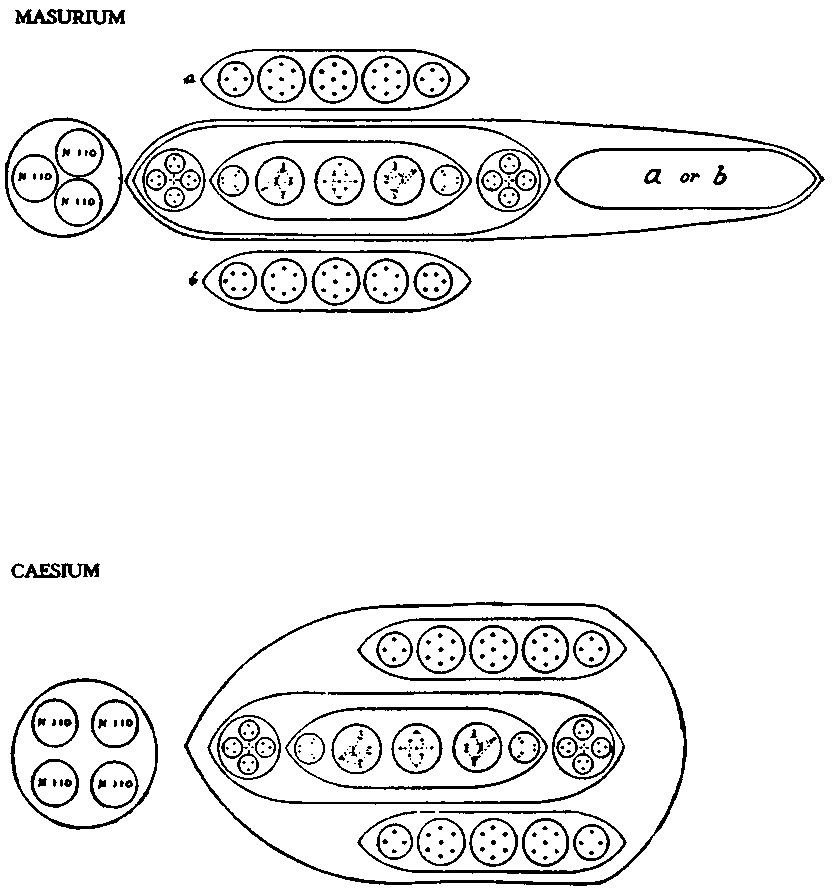
FIG. 24. MASURIUM, CAESIUM
THE SPIKE GROUP 53
ATOMIC NO. 43. MASURIUM
Masurium was recorded by clairvoyant observation in 1909 and discovered spectroscopically in 1931. There are two varieties, each containing the same total number of Anu.
Like Rubidium, Masurium, has sixteen spikes. Each spike contains the Li63 group and an ovoid. The ovoids each contain 29 Anu, but in different atoms these vary in their arrangements, as shown in Fig. 24.
The central globe contains three N110.
Masurium 3N110 + 16 [Li63 + Ma29 (a or b)]
| Central globe |
|
|
|
| 16 Spikes of 92 Anu |
|
|
|
|
|
|||
|
|
|
|
|
|
|
|||
|
|
|
|
|
|
|
ATOMIC NO. 55 CAESIUM
Caesium is in many ways similar to its predecessors. It contains sixteen spikes, each consisting of one Li63 and two smaller ovoids of 29 Anu similar to those in the a variety of Masurium.
The central globe consists of four N110 groups.
Caesium = 4N110 + 16 (Li63 + 2 Ma29a)
| Central globe |
|
|
|
| 16 Spikes of 121 Anu |
|
|
|
|
|
|||
|
|
|
|
|
|
|
|||
|
|
|
|
|
|
|
54 OCCULT CHEMISTRY

FIG. 24. ILLINIUM, THULIUM
THE SPIKE GROUP 55
ATOMIC NO. 61 ILLINIUM
Illinium also contains sixteen spikes, but each contains two Li63 groups and a tiny floating cap. Alternate spikes have caps of nine and fourteen Anu respectively. The central globe contains four N110 groups.
Illinium = 4N110 + 16 (2Li63 + Il.9 or Il.14)
| Central globe |
|
|
|
| 8 Spikes of 135 Anu |
|
|
|
| 8 Spikes of 140 Anu |
|
|
|
|
|
|||
|
|
|
|
|
|
|
|||
|
|
|
|
|
|
|
ISOTOPE OF ILLINIUM
A curious fact is that a single atom of Illinium was found which appears to he a variant of Illinium; an absolutely unique specimen, identical with Illinium except that the two little caps contain seventeen and eighteen Anu respectively, instead of nine and fourteen. This gives a total of 2736 Anu which would give a number weight of 152.
Illinium b. = 1N110 + 16 (2Li63 + Il.17 or Il.18)
| Central globe |
|
|
|
| 8 Spikes of 135 Anu |
|
|
|
| 8 Spikes of 140 Anu |
|
|
|
|
|
|||
|
|
|
|
|
|
|
|||
|
|
|
|
|
|
|
ATOMIC NO. 69. THULIUM
Thulium is anther sixteen spike element.
Each spike consists of two Li63 groups revolving round a smaller central column of 40 Anu. This central column contains three ovoids.
The central globe contains four N110 groups.
It is noteworthy that Thulium contains exactly the same number of Anu as the isotope of Kalon, Meta-Kalon.
Thulium = 4N110 + 16 (2Li63 + Tm40).
| Central globe |
|
|
|
| 16 Spikes of 166 Anu |
|
|
|
|
|
|||
|
|
|
|
|
|
|
|||
|
|
|
|
|
|
|
56 OCCULT CHEMISTRY
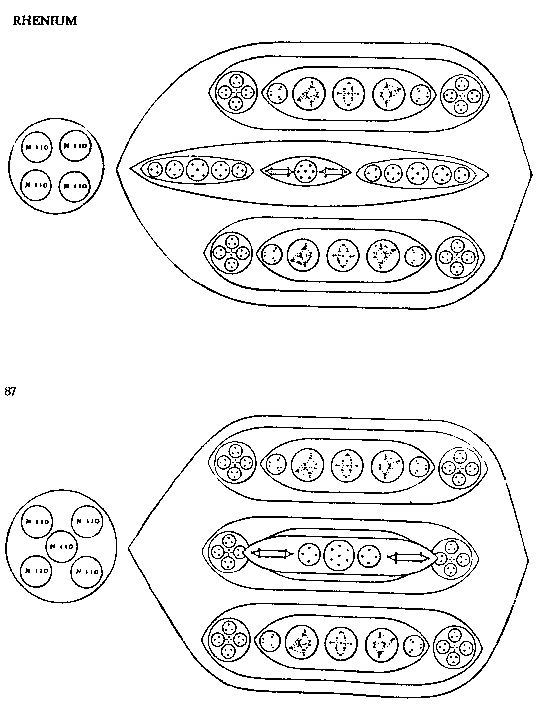
FIG. 26. RHENIUM, NO. 87
THE SPIKE GROUP 57
ATOMIC NO. 75. RHENIUM
Rhenium was examined in 1931, having been isolated by science in 1922.
It contains sixteen spikes. Each spike is composed of two Li63 groups and a third ovoid containing 57 Anu.
The central globe is composed of four N110 groups.
Rhenium = 4N110 + 16 (2Li63 + Re57)
| Central globe |
|
|
|
| 16 Spikes of 183 Anu |
|
|
|
|
|
|||
|
|
|
|
|
|
|
|||
|
|
|
|
|
|
|
ATOMIC NO. 87. 87
This element, with atomic number 87, was reported by science in 1930. It is very unstable.
It contains sixteen spikes, each spike being composed of three Li63 groups and a fourth ovoid containing 27 Anu.
The central globe contains 5N110.
87 = 5N110 + 16 (3Li63 + 87.27)
| Central globe |
|
|
|
| 16 Spikes of 216 Anu |
|
|
|
|
|
|||
|
|
|
|
|
|
|
|||
|
|
|
|
|
|
|
58 OCCULT CHEMISTRY
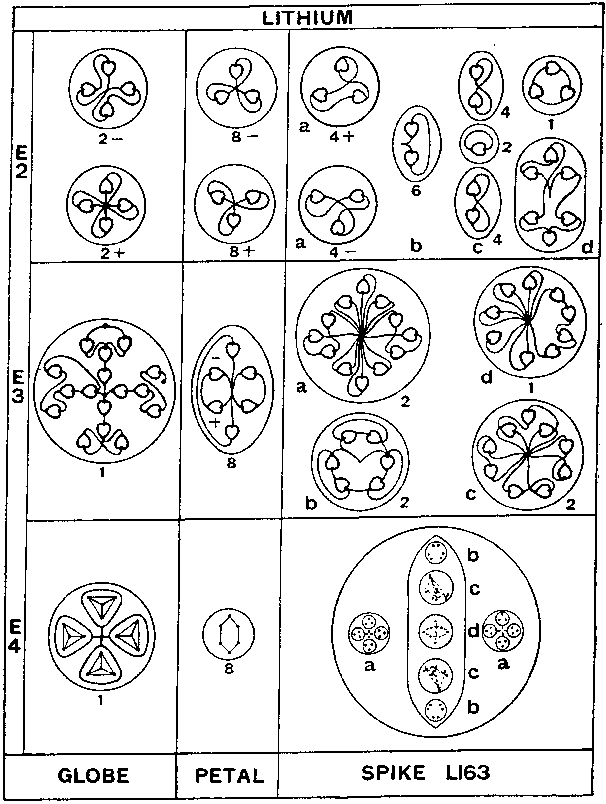
FIG. 27. DISINTIGRATION OF LITHIUM
THE SPIKE GROUP 59
DISINTEGRATION OF ELEMENTS OF THE SPIKE GROUP
Lithium, Fluorine, Potassium and Rubidium are the only elements in this group dealt with in detail.
DISINTEGRATION OF LITHIUM
The Lithium atom first breaks up on the E4 level into a globe, eight petals and one spike. Fig. 27. The Globe. 4Li4. On the E4 level this forms a sphere containing 16 Anu arranged as four tetrahedrons.
On the E3 level these become a group of sixteen Anu.
On the E2 level four quartets are liberated, two positive and two negative. The Petal. Ad6. This group is identical with the Ad6 'cigar' or prism already dealt with under Adyarium. On the E4 level eight of these are liberated.
On the E3 level they give positive and negative sextets.
On the E2 level each sextet gives two triads, one positive and one negative The Spike. Li63. On the E4 level the spike rearranges itself so as to form having the ovoid in the centre and the small spheres to left and right of it.
On the E3 level the spike breaks up into seven bodies.
| (a) | Two groups, |
|
of | 12 | Anu |
| (b) | Two groups, |
|
of | 6 | " |
| (c) | Two groups, |
|
of | 9 | " |
| (d) | One group, | of | 9 | " |
On the E2 level further disintegration occurs.
|
|
(a) |
|
4 triads, | 4 positive and 4 negative. | 8 |
|
in all |
|
|
(b) |
|
3 duads | 6 |
|
in all | |
|
|
(b) |
|
4 duads | and a unit | 10 |
|
in all |
|
|
(b) |
|
a sextet | and a triplet | 2 |
|
in all |
Thus the total number of bodies on the E2 level is twenty-six.
On the El level all break up into single Anu.
60 OCCULT CHEMISTRY
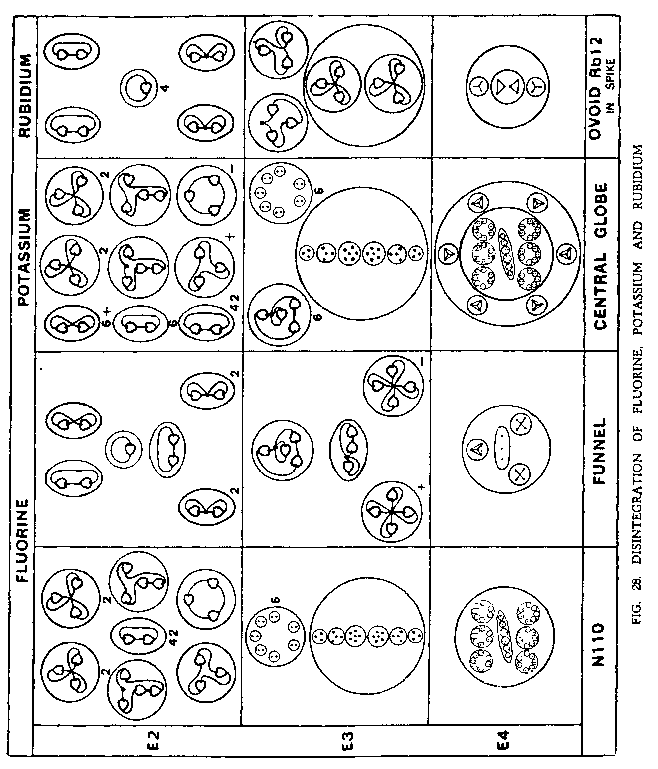
THE SPIKE GROUP 61
DISINTEGRATION OF FLUORINE, POTASSIUM, AND RUBIDIUM
FLUORINE
The main body of this element is formed by two N110 groups. Fig. 28.
On the E4 level they float off independently.
On the E3 level the central ellipse forms a sphere while the six spheres of seven duads, N14, are liberated.
On the E2 level the ellipse gives six triplets and two quartets and each N14 gives seven duads.
The funnels of Fluorine separate on the E4 level and are set free, becoming spheres.
On the E3 level the funnels set free their contained bodies, each funnel giving three quartets and a triad.
On the E2 level seven duads and a unit are formed.
POTASSIUM
On the E4 level one globe and nine spikes are liberated. The globe. The central part of the globe is the N110 group. Fig. 28.
On the E4 level this forms a sphere surrounded by the six little tetrahedrons, 6Li4.
On the E3 level the N110 disintegrates into a sphere and six N14, as already described under Fluorine, while the Li4 tetrahedrons are liberated as quartets. Thirteen bodies are thus liberated on this level.
On the E2 level the quartets Li4 each give two duads while the N14 each give seven duads and the ellipse six triplets and two quartets. Half of these are positive and half negative.
The Spikes. The spikes Li63 are identical with those in Lithium and their behaviour is as shown under that element. Fig. 27.
RUBIDIUM
Rubidium gives sixteen spikes and three N110 on the E4 level.
The Globe. The central globe has three N110. Each of these is liberated on the E4 level and its disintegration proceeds as in the previous elements. Figs. 27, 28.
The Spikes. The spikes are more complicated than those of Lithium as they contain an extra ovoid Rb12. The Li63 group from the spike forms a sphere and behaves as in Lithium at all levels, as shown in Fig. 27. The ovoid Rb12 has a somewhat unusual form.
On the E4 level the triangles of the sextet revolve round each other.
On the E3 level the ovoid gives two triads and a sextet with two distinct triads.
On the E2 level the triads give duads and units.
62 OCCULT CHEMISTRY
Figure 29 shows in a condensed form all the elements of the spike group. The relationships and the way each atom is built up from a few constituents can be easily observed.
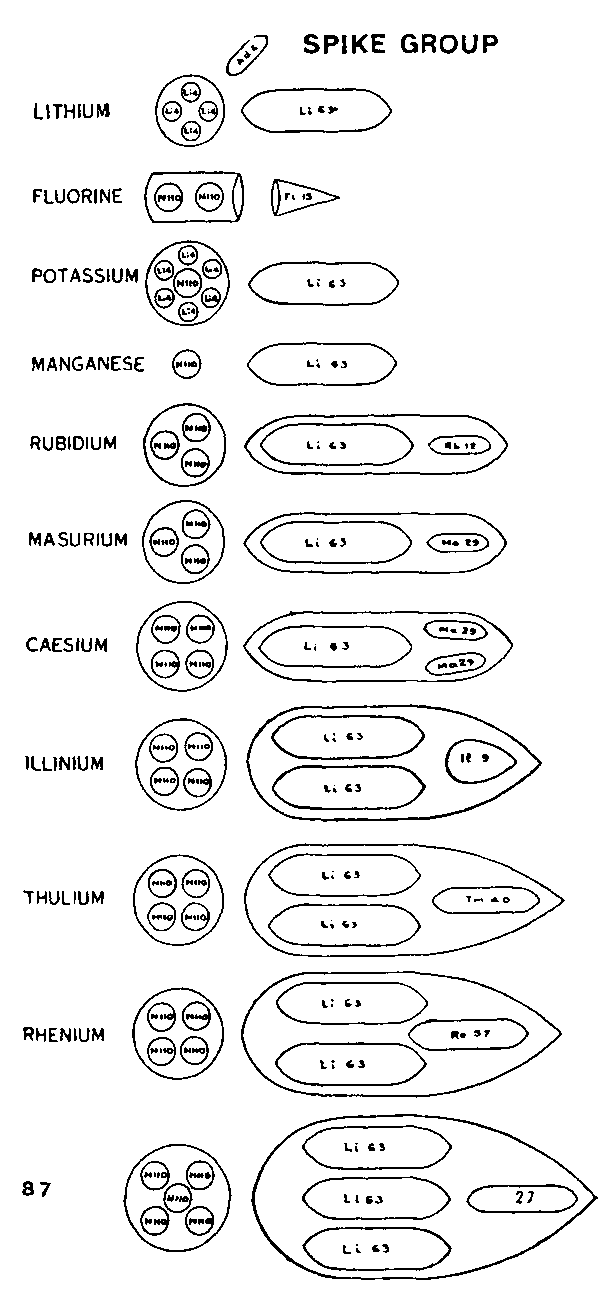
FIG. 29